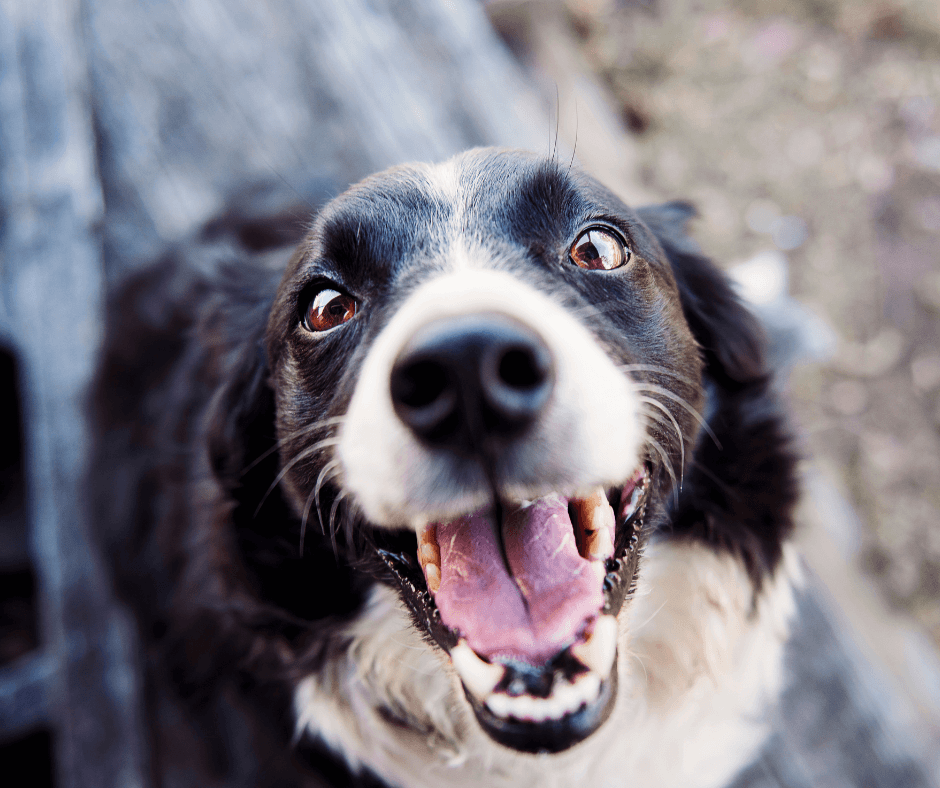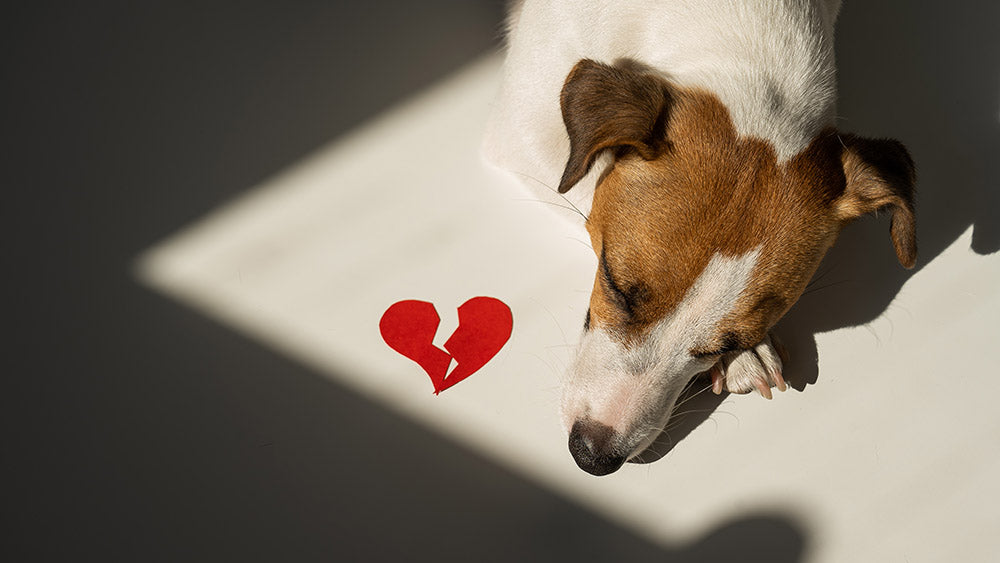In this article
How Do You Know if Your Dog is Happy?
When it comes to people, we can usually tell if someone is happy because they are smiling. When it comes to dogs, we typically say that a dog is happy when you see them wagging their tail. In addition, some dogs do what almost looks like a grin, while others are more the strong and brooding types. So does that mean that one of those dogs is happier than another?
This made us ask the question: do dogs actually smile and is it a sign that they are happy?
Most long-term dog owners and experts do believe that dogs smile when they’re happy and relaxed. We have all seen that grin when we see a dog wagging its tail with its mouth hanging open, lips pulled back, and ears drooping down and relaxed. But the question ‘do dogs truly smile?’ remains. Are they smiling, or is it just a facial expression resembling a smile?
Do Dogs Really Smile When They Are Happy?
Dogs are known to smile when they know that their human owners love them. Since they are exceptionally good at reading human body language and are masters of non-verbal communication, they can recognize that smiling is an act well appreciated by humans, and it triggers them to do the same to us. They can sense the comfort in the tone of their owner’s voices, and this is positively reinforcement for the dog. It makes them do it repeatedly until they are assured that this is acceptable behavior.
The Mistaken Grin
This is the one that resembles a grin but is not a grin. Sometimes when a dog has run a long distance and is panting, it may open its mouth wide and try to take in as much air as it can down its throat. This is often mistaken for a smile or a grin.

The Submissive Grin
Another canine expression that is mistaken for a smile is the submissive grin. This is the term given by dog experts and is used to describe the expression dogs make when trying to express that they are not a threat. This 'smile' is characterized by a lowered posture, squinting eyes, bared teeth, and an upturned neck.
This is also known as an ‘appeasement gesture’ and is a common facial expression that dogs use when first meeting someone new - human or dog.
Younger dogs use this gesture to protect themselves from older dogs when they first encounter them. This non-threatening gesture should not be confused with a snarl or an aggressive emotion.
Positive Encouragement
According to research on Animal Cognition, the way you speak to your dog has a big influence on them. Speaking to your dog in a melodious and kind tone and saying words of encouragement such as ‘Atta boy’ and ‘who’s a good boy?’ have been shown to be appreciated by dogs.
Dogs enjoy the company of owners that speak to them in this manner. Wouldn't you? 😊
Signs of a Happy Dog
Dogs are generally expressive creatures and do not hide their emotions, especially when expressing love and affection.
Here are some tell-tale signs that your dog is happy:
- Vigorously Wags Its Tail
A dog’s tail and position can tell a lot about it and its emotions. A dog that vigorously wags its tail is usually excited and happy.
- Enjoys Walks and Play Time
Unless your dog is aging or falling sick, dogs typically enjoy going on walks and playtime. If you can ease their joint and hip pain, even senior dogs can enjoy going to the dog park or even just going for a walk around the neighborhood and meeting other dogs.
- Has a Good Appetite
A happy dog has a good appetite. While it doesn’t hog, it finishes the required amount that it should be eating and enjoys receiving treats. Of course you need to make sure that you don't give too many treats as dogs, just like us humans, can easily become overweight if they eat too much and don't get enough exercise

- Is Friendly towards Other Animals and Humans
A happy dog will not snarl or growl at other dogs and humans. Most dogs will either ignore this kind of distraction, or will engage the other dog, cat or human. These are all signs that your dog is in a good mood.
Even if the dog just does their own thing when others are around, this is not necessarily a sign that they are unhappy. As long as they are not aggressive, the disinterest to play can mean just that they are more interested in something else.
- Softens Its Eyes and Relaxes Their Ears
Happy dogs have relaxed and softened eyes and blink often. Another sign of when a dog is happy and relaxed is its ears flop forward or flatten. This shows that the dog is completely relaxed.
Ears that are pinned back or erect signify a dog that is prepared for fight or flight.
- Lays On Its Back
Happy dogs like to put their belly out and lay on their back with their tongues hanging out. This is a very telling relaxed pose, and some dogs even fall asleep like this. This is also a very clear sign of trust, in that dogs will only show their belly to someone they have complete confidence in.
Since dogs love being scratched and rubbed in this position they only lie in it when they feel relaxed, happy, and comfortable.

- Wriggles Its Body
When a dog is happy or excited, it will wag its tail vigorously; this can cause their entire body to shake and wriggle. Its general body language will be relaxed and calm.
- Behaves Well
A dog that is not being destructive or disobedient and generally well-behaved is considered a non-stressed and happy dog. Disobedience in dogs is usually caused by boredom or lack of mental stimulation in dogs.
Do Dogs Smile At Other Dogs?
Dogs communicate with other dogs using their entire bodies. They may ask them to play or back off when they don’t want them coming near them, their owners, or even their property. Dogs have their own ways of communicating, but they rarely smile at each other.
Do Dogs Smile At Humans?
Dogs probably smile at humans due to a phenomenon called ‘laughter contagion.’ Just as one person’s laughter in a room can trigger more people to laugh, a happy person’s smile can make their dog smile back at them. Smiling dogs are appreciated and encouraged, and dogs will learn that this is good behavior due to the happy reaction it stimulates, and so they will do it more.
Do Dogs Smile With Their Teeth?
Dogs have different facial expressions, and they may grin and show their teeth as a sign of submission or guilt. You may have noticed when a dog makes a mess or damages something and the owner scolds the dog in a firm tone, the dog lowers its body and head and shows its teeth. However, this is not a happy grin but a submissive one.
Dogs do that when they’re feeling guilty or uncomfortable and may make this gesture. This should not be confused with a mischievous grin. It’s always a good idea to observe the dog’s body language before making a judgment of its behavior and emotions.
Can Dogs Be Trained To Smile?
Dogs can be trained in many things, from good behavior to tricks and to even chasing away strangers. But can they be taught how to smile?
Here are some ways that you might be able to train your dog to smile.

1. Repeat
You must keep repeating the commands that you want your dog to follow. Once your dog perfects them, make sure to reward the dog. Repetition is a great way to make dogs remember a command and is a successful method used in training.
2. Reward
Dogs love treats and associate being treated with good behavior. Every time they are told to smile and follow the command, they must be rewarded with a treat. This is seen as positive reinforcement and encouragement. Dogs will repeat and follow commands in the hope of being rewarded.
3. Be Attentive
Watch and observe your dog to see what makes them show their teeth and get excited. Notice if your dog gets excited and smiles every time it hears the car keys and knows you’re taking it for a walk. You can say ‘smile’ and offer your dog a treat. Your dog will then associate smiling with the sound of the keys and receiving a treat.
4. Be Consistent
Consistency is key. You must keep repeating the same behavior repeatedly, and eventually, they will learn. Training sessions shouldn’t ideally go on for more than ten to fifteen minutes. Otherwise, your dog might become irritable and disobedient. Repeating the same routine can help the dog learn and memorize the behavior until it comes naturally to it.
5. Be Patient
It is important to remember to maintain a kind and compassionate tone. Another important tip to remember is to be patient. It might not happen in a day, a week, or even a month, but you will definitely see progress, and eventually, your dog will learn the command. Scolding or losing your temper with your dog will get you nowhere, and your training session will fail.
Being patient and kind will help train your dog as well as keep it healthy and happy. Just as children, dogs need to be trained with kindness and compassion, but when they need to be disciplined, it is important to use a firm tone. Being abusive or rough with your dog can backfire and cause your dog to become anxious and sad, and even cause them to fall ill.
Do Dogs Smile to Make Us Feel Better?
Many dog owners say that their dogs are excellent listeners and have a fascinating way of always knowing exactly how they are feeling. Dogs are extremely affectionate and loving creatures and are among the few animals that enjoy the company of humans. This is why many believe that "a dog is man (or woman's) best friend".
It's true that dogs can be quite perceptive and can be a great source of comfort for their owners when they are feeling depressed and sad. And whether they are actually smiling, their presence is enough to make us feel better.
Smile More 😍
Just as humans have emotions, dogs too have their individual personalities and emotions, and each may be different. They must be respected and understood. While it may not be possible to confirm whether dogs smile, there are other ways to know if your dog is happy. This can be done by observing your dog’s body language and general responses and behavior.
Remember, kindness and patience are key when dealing with dogs, as sometimes it is difficult to understand what they might need. And no matter what, it never hurts to smile at your dog (one day they may just smile back).



